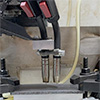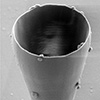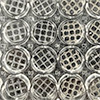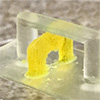 Researchers have developed a metallic gel that is highly electrically conductive and can be used to print three-dimensional (3D) solid objects at room temperature. Printed objects can be engineered to change shape as the gel dries.
Researchers have developed a metallic gel that is highly electrically conductive and can be used to print three-dimensional (3D) solid objects at room temperature. Printed objects can be engineered to change shape as the gel dries.
Jul 6th, 2023
Read more
 Taking a cue from the structural complexity of trees and bones, engineers have created a way to 3D-print two types of steel in the same circular layer using two welding machines. The resulting bimetallic material proved 33% to 42% stronger than either metal alone.
Taking a cue from the structural complexity of trees and bones, engineers have created a way to 3D-print two types of steel in the same circular layer using two welding machines. The resulting bimetallic material proved 33% to 42% stronger than either metal alone.
Jun 22nd, 2023
Read more
 Researchers have 3D-printed the world's smallest wine glass - nearly indistinguishable with the naked eye - with a rim smaller than the width of a human hair.
Researchers have 3D-printed the world's smallest wine glass - nearly indistinguishable with the naked eye - with a rim smaller than the width of a human hair.
Jun 20th, 2023
Read more
 We are one step closer to naturally compostable robots now that researchers can 3D print actuators using a bio-ink made from seaweed.
We are one step closer to naturally compostable robots now that researchers can 3D print actuators using a bio-ink made from seaweed.
Jun 17th, 2023
Read more
 A new Jell-O-like material could replace metals as electrical interfaces for pacemakers, cochlear implants, and other electronic implants.
A new Jell-O-like material could replace metals as electrical interfaces for pacemakers, cochlear implants, and other electronic implants.
Jun 15th, 2023
Read more
 Researchers for the first time successfully combined volumetric bioprinting with melt electrowriting. This combines the speed and cell-friendliness of volumetric printing with the structural strength needed to create functional blood vessels.
Researchers for the first time successfully combined volumetric bioprinting with melt electrowriting. This combines the speed and cell-friendliness of volumetric printing with the structural strength needed to create functional blood vessels.
Jun 7th, 2023
Read more
 A hybrid organic-inorganic polymer resin enables the three-dimensional (3D) printing of nanoscale optical-grade glass at temperatures roughly half of what other approaches require.
A hybrid organic-inorganic polymer resin enables the three-dimensional (3D) printing of nanoscale optical-grade glass at temperatures roughly half of what other approaches require.
Jun 1st, 2023
Read more
 Researchers demonstrated that it's possible to make carbon dioxide capture filters using 3D printing. Specifically, they printed a hydrogel material that can hold carbonic anhydrase, an enzyme that speeds a reaction that turns carbon dioxide and water into bicarbonate.
Researchers demonstrated that it's possible to make carbon dioxide capture filters using 3D printing. Specifically, they printed a hydrogel material that can hold carbonic anhydrase, an enzyme that speeds a reaction that turns carbon dioxide and water into bicarbonate.
May 31st, 2023
Read more
 Researchers created a new method of 3D printing that uses near-infrared (NIR) light to create complex structures containing multiple materials and colours.
Researchers created a new method of 3D printing that uses near-infrared (NIR) light to create complex structures containing multiple materials and colours.
May 31st, 2023
Read more
 A team of researchers has created a new class of titanium alloys that are strong and not brittle under tension, by integrating alloy and 3D-printing process designs. The technique could help extend the applications of titanium alloys, improve sustainability and drive innovative alloy design.
A team of researchers has created a new class of titanium alloys that are strong and not brittle under tension, by integrating alloy and 3D-printing process designs. The technique could help extend the applications of titanium alloys, improve sustainability and drive innovative alloy design.
May 31st, 2023
Read more
 Researchers have created a novel 3D printing method that produces materials in ways that conventional manufacturing can't match. The new process mixes multiple aerosolized nanomaterial inks in a single printing nozzle, varying the ink mixing ratio on the fly during the printing process.
Researchers have created a novel 3D printing method that produces materials in ways that conventional manufacturing can't match. The new process mixes multiple aerosolized nanomaterial inks in a single printing nozzle, varying the ink mixing ratio on the fly during the printing process.
May 19th, 2023
Read more
 Researchers have invented a process that relies solely on the shape of the object for a time-controlled release. This will have important implications for the pharmaceutical industry, which has recently begun focusing sharply on 3D printing.
Researchers have invented a process that relies solely on the shape of the object for a time-controlled release. This will have important implications for the pharmaceutical industry, which has recently begun focusing sharply on 3D printing.
May 16th, 2023
Read more
 Sweat holds vital information about our health, providing clues to dehydration, fatigue, blood sugar levels and even serious conditions such as cystic fibrosis, diabetes and heart failure. Researchers have taken a giant leap forward in sweat analysis with an innovative 3D-printed wearable sweat sensor called the 'sweatainer'.
Sweat holds vital information about our health, providing clues to dehydration, fatigue, blood sugar levels and even serious conditions such as cystic fibrosis, diabetes and heart failure. Researchers have taken a giant leap forward in sweat analysis with an innovative 3D-printed wearable sweat sensor called the 'sweatainer'.
May 4th, 2023
Read more
 The device would be a key component of a portable mass spectrometer that could help monitor pollutants, perform medical diagnoses in remote areas, or test Martian soil.
The device would be a key component of a portable mass spectrometer that could help monitor pollutants, perform medical diagnoses in remote areas, or test Martian soil.
Apr 25th, 2023
Read more
 In the pursuit of innovative solutions that harmoniously blend with the natural world, researchers have developed the first 3D-printed seed-robot, known as I-Seed.
In the pursuit of innovative solutions that harmoniously blend with the natural world, researchers have developed the first 3D-printed seed-robot, known as I-Seed.
Apr 19th, 2023
Read more
 Researchers have combined 3D printing and electric poling into a single process called electric poling-assisted additive manufacturing, or EPAM. It aligns the dipoles in PVdf filament during the printing, which leads to a better indication of the stress being applied.
Researchers have combined 3D printing and electric poling into a single process called electric poling-assisted additive manufacturing, or EPAM. It aligns the dipoles in PVdf filament during the printing, which leads to a better indication of the stress being applied.
Apr 17th, 2023
Read more
 Researchers have developed a 3D bioprinter - a machine that can print 3D structures using living cells and other biological materials - for cancer research.
Researchers have developed a 3D bioprinter - a machine that can print 3D structures using living cells and other biological materials - for cancer research.
Apr 4th, 2023
Read more
 Chemical engineers have extended the centuries-old practice to produce intricate shapes made of glass or other hard materials. Their thoroughly modern method, which can be combined with 3D printing, could have applications ranging from sculpture to catalysis and beyond.
Chemical engineers have extended the centuries-old practice to produce intricate shapes made of glass or other hard materials. Their thoroughly modern method, which can be combined with 3D printing, could have applications ranging from sculpture to catalysis and beyond.
Mar 28th, 2023
Read more
 Researchers have developed a metallic gel that is highly electrically conductive and can be used to print three-dimensional (3D) solid objects at room temperature. Printed objects can be engineered to change shape as the gel dries.
Researchers have developed a metallic gel that is highly electrically conductive and can be used to print three-dimensional (3D) solid objects at room temperature. Printed objects can be engineered to change shape as the gel dries.
 Subscribe to our 3D Printing News feed
Subscribe to our 3D Printing News feed















